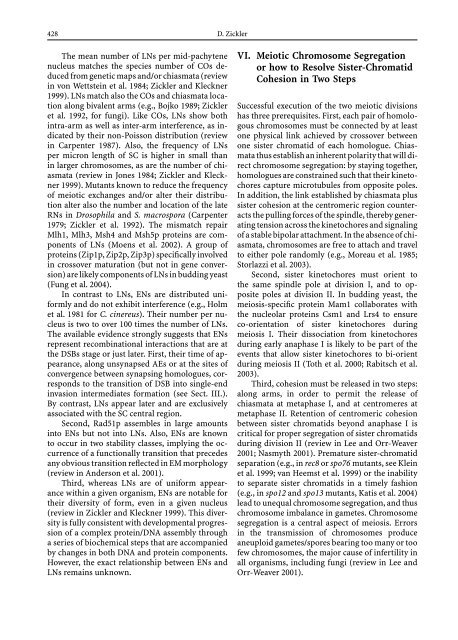Growth, Differentiation and Sexuality
Growth, Differentiation and Sexuality
Growth, Differentiation and Sexuality
You also want an ePaper? Increase the reach of your titles
YUMPU automatically turns print PDFs into web optimized ePapers that Google loves.
428 D. Zickler<br />
ThemeannumberofLNspermid-pachytene<br />
nucleus matches the species number of COs deduced<br />
from genetic maps <strong>and</strong>/or chiasmata (review<br />
in von Wettstein et al. 1984; Zickler <strong>and</strong> Kleckner<br />
1999). LNs match also the COs <strong>and</strong> chiasmata location<br />
along bivalent arms (e.g., Bojko 1989; Zickler<br />
et al. 1992, for fungi). Like COs, LNs show both<br />
intra-arm as well as inter-arm interference, as indicated<br />
by their non-Poisson distribution (review<br />
in Carpenter 1987). Also, the frequency of LNs<br />
per micron length of SC is higher in small than<br />
in larger chromosomes, as are the number of chiasmata<br />
(review in Jones 1984; Zickler <strong>and</strong> Kleckner<br />
1999). Mutants known to reduce the frequency<br />
of meiotic exchanges <strong>and</strong>/or alter their distribution<br />
alter also the number <strong>and</strong> location of the late<br />
RNs in Drosophila <strong>and</strong> S. macrospora (Carpenter<br />
1979; Zickler et al. 1992). The mismatch repair<br />
Mlh1, Mlh3, Msh4 <strong>and</strong> Msh5p proteins are components<br />
of LNs (Moens et al. 2002). A group of<br />
proteins (Zip1p, Zip2p, Zip3p) specifically involved<br />
in crossover maturation (but not in gene conversion)<br />
are likely components of LNs in budding yeast<br />
(Fung et al. 2004).<br />
In contrast to LNs, ENs are distributed uniformly<br />
<strong>and</strong> do not exhibit interference (e.g., Holm<br />
et al. 1981 for C. cinereus). Their number per nucleus<br />
is two to over 100 times the number of LNs.<br />
The available evidence strongly suggests that ENs<br />
represent recombinational interactions that are at<br />
the DSBs stage or just later. First, their time of appearance,<br />
along unsynapsed AEs or at the sites of<br />
convergence between synapsing homologues, corresponds<br />
to the transition of DSB into single-end<br />
invasion intermediates formation (see Sect. III.).<br />
By contrast, LNs appear later <strong>and</strong> are exclusively<br />
associated with the SC central region.<br />
Second, Rad51p assembles in large amounts<br />
into ENs but not into LNs. Also, ENs are known<br />
to occur in two stability classes, implying the occurrence<br />
of a functionally transition that precedes<br />
any obvious transition reflected in EM morphology<br />
(review in Anderson et al. 2001).<br />
Third, whereas LNs are of uniform appearance<br />
within a given organism, ENs are notable for<br />
their diversity of form, even in a given nucleus<br />
(review in Zickler <strong>and</strong> Kleckner 1999). This diversity<br />
is fully consistent with developmental progression<br />
of a complex protein/DNA assembly through<br />
a series of biochemical steps that are accompanied<br />
by changes in both DNA <strong>and</strong> protein components.<br />
However, the exact relationship between ENs <strong>and</strong><br />
LNs remains unknown.<br />
VI. Meiotic Chromosome Segregation<br />
or how to Resolve Sister-Chromatid<br />
Cohesion in Two Steps<br />
Successful execution of the two meiotic divisions<br />
has three prerequisites. First, each pair of homologous<br />
chromosomes must be connected by at least<br />
one physical link achieved by crossover between<br />
one sister chromatid of each homologue. Chiasmata<br />
thus establish an inherent polarity that will direct<br />
chromosome segregation: by staying together,<br />
homologues are constrained such that their kinetochores<br />
capture microtubules from opposite poles.<br />
In addition, the link established by chiasmata plus<br />
sister cohesion at the centromeric region counteracts<br />
the pulling forces of the spindle, thereby generating<br />
tension across the kinetochores <strong>and</strong> signaling<br />
of a stable bipolar attachment. In the absence of chiasmata,<br />
chromosomes are free to attach <strong>and</strong> travel<br />
to either pole r<strong>and</strong>omly (e.g., Moreau et al. 1985;<br />
Storlazzi et al. 2003).<br />
Second, sister kinetochores must orient to<br />
the same spindle pole at division I, <strong>and</strong> to opposite<br />
poles at division II. In budding yeast, the<br />
meiosis-specific protein Mam1 collaborates with<br />
the nucleolar proteins Csm1 <strong>and</strong> Lrs4 to ensure<br />
co-orientation of sister kinetochores during<br />
meiosis I. Their dissociation from kinetochores<br />
during early anaphase I is likely to be part of the<br />
events that allow sister kinetochores to bi-orient<br />
during meiosis II (Toth et al. 2000; Rabitsch et al.<br />
2003).<br />
Third, cohesion must be released in two steps:<br />
along arms, in order to permit the release of<br />
chiasmata at metaphase I, <strong>and</strong> at centromeres at<br />
metaphase II. Retention of centromeric cohesion<br />
between sister chromatids beyond anaphase I is<br />
critical for proper segregation of sister chromatids<br />
during division II (review in Lee <strong>and</strong> Orr-Weaver<br />
2001; Nasmyth 2001). Premature sister-chromatid<br />
separation (e.g., in rec8 or spo76 mutants, see Klein<br />
et al. 1999; van Heemst et al. 1999) or the inability<br />
to separate sister chromatids in a timely fashion<br />
(e.g., in spo12 <strong>and</strong> spo13 mutants, Katis et al. 2004)<br />
lead to unequal chromosome segregation, <strong>and</strong> thus<br />
chromosome imbalance in gametes. Chromosome<br />
segregation is a central aspect of meiosis. Errors<br />
in the transmission of chromosomes produce<br />
aneuploid gametes/spores bearing too many or too<br />
few chromosomes, the major cause of infertility in<br />
all organisms, including fungi (review in Lee <strong>and</strong><br />
Orr-Weaver 2001).

















